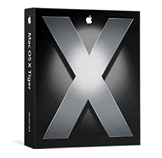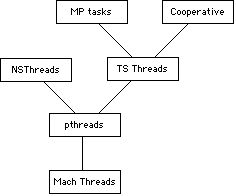No more mysteries: Apple's G5 versus x86, Mac OS X versus Linux
by Johan De Gelas on June 3, 2005 7:48 AM EST- Posted in
- Mac
Mac OS X: beautiful but...
The Mac OS X (Server) operating system can't be described easily. Apple:
While there are many very good ideas in Mac OS X, it reminds me a lot of fusion cooking, where you make a hotch-potch of very different ingredients. Let me explain.

Hexley the platypus, the Darwin mascot
Everything else is located in smaller programs, servers, which communicate with each other via ports and an IPC (Inter Process Communication) system. Explaining this in detail is beyond the scope of this article (read more here). But in a nutshell, a Mach microkernel should be more elegant, easier to debug and better at keeping different processes from writing in eachother's protected memory areas than our typical "monolithic" operating systems such as Linux and Windows NT/XP/2000. The Mach microkernel was believed to be the future of all operating systems.
However, you must know that applications (in the userspace) need, of course, access to the services of the kernel. In Unix, this is done with a Syscall, and it results in two context switches (the CPU has to swap out one process for another): from the application to the kernel and back.
The relatively complicated memory management (especially if the server process runs in user mode instead of kernel) and IPC messaging makes a call to the Mach kernel a lot slower, up to 6 times slower than the monolithic ones!
It also must be remarked that, for example, Linux is not completely a monolithic OS. You can choose whether you like to incorporate a driver in the kernel (faster, but more complex) or in userspace (slower, but the kernel remains slimmer).
Now, while Mac OS X is based on Mach 3, it is still a monolithic OS. The Mach microkernel is fused into a traditional FreeBSD "system call" interface. In fact, Darwin is a complete FreeBSD 4.4 alike UNIX and thus monolithic kernel, derived from the original 4.4BSD-Lite2 Open Source distribution.
The current Mac OS X has evolved a bit and consists of a FreeBSD 5.0 kernel (with a Mach 3 multithreaded microkernel inside) with a proprietary, but superb graphical user interface (GUI) called Aqua.
Performance problems
As the mach kernel is hidden away deep in the FreeBSD kernel, Mach (kernel) threads are only available for kernel level programs, not applications such as MySQL. Applications can make use of a POSIX thread (a " pthread"), a wrapper around a Mach thread.
Mac OS X thread layering hierarchy (Courtesy: Apple)
In order to maintain binary compatibility, Apple might not have been able to implement some of the performance improvements found in the newer BSD kernels.
Another problem is the way threads could/can get access to the kernel. In the early versions of Mac OS X, only one thread could lock onto the kernel at once. This doesn't mean only one thread can run, but that only one thread could access the kernel at a given time. So, a rendering calculation (no kernel interaction) together with a network access (kernel access) could run well. But many threads demanding access to the memory or network subsystem would result in one thread getting access, and all others waiting.
This "kernel locked bottleneck" situation has improved in Tiger, but kernel locking is still very coarse. So, while there is a very fine grained multi-threading system (The Mach kernel) inside that monolithic kernel, it is not available to the outside world.
So, is Mac OS X the real reason why MySQL and Apache run so slow on the Mac Platform? Let us find out... with benchmarks, of course!










116 Comments
View All Comments
seanp789 - Saturday, June 4, 2005 - link
well thats great and all but yours news says apple is switchign to intel so i dont think much will be changing in the power pc lineupBrazilian Joe - Saturday, June 4, 2005 - link
I would like to see this Article re-done, with more benches to give a clearer picture. I think MACOS X should be pitched against Darwin in the PPC platform, since there may be hidden differences. Darwin works on x86 too (and x86_64?), it would be very interesting to see the SAME OS under the Mac Platform running on different hardware. And having the software compiled with the same compiler present on Darwin, we should get a more consistent result. Linux and BSD should not be ditched, however. The perfornance difference Of linux/FreeBSD/OpenBSD in PPC vs PC is also a very interesting subject to investigate.I think this article, along with all the complaints of inconsistency in the results, sohuld fuel a new series of articles: One, Just comparing Darwin/MacOS X on Both platforms. Another For Linux, using a GCC version as close as possible to that used on Darwin. Another for FreeBSD, and yet another for OpenBSD. The last article Would get everything and summarize. I think this would be much more complete and satisfying/informative for the reader crowd.
iljitsch - Saturday, June 4, 2005 - link
There seems to be considerable confusion between threads and processes in the review. I have no trouble believing that MacOS doesn't do so well with process gymnastics, but considering the way Apple itself leverages threads, I would assume those perform much better.I don't understand why Apache 1.3 was used here, Apache 2.0 has much better multiprocessor capabilities and would have allowed to test the difference between the request-are-handled-in-processes and requests-are-handled-in-threads ways of doing things.
Phil - Saturday, June 4, 2005 - link
#79: Wow. I had no idea that they were actually going to do it, I had assumed that it was typical industry nonsense!If this is true, then IMHO Apple won't be in much of a better position (with regards to this article) as they'll still need to work on the OS, regardless.
Can anyone speculate as to why they *really* want to switch to x86/Intel? I wonder if they'll consider AMD too...
rorsten - Saturday, June 4, 2005 - link
Uhm, the estimation for power consumption is completely wrong. The only significant CMOS power consumption - especially for an SOI chip - is the current required to charge or discharge the gates of the FETs, which only happens when a value changes (the clock accounts for most of the power consumption on a modern synchronous chip). Since we're talking about current only, this is purely resistive power, I^2R style, and since the current is related to the number of transitions per second, increasing the clock rate linearly increases the current which quadratically increases the power consumption.kamper - Saturday, June 4, 2005 - link
Here's another story about Apple and Intel from cnet:http://news.com.com/Apple+to+ditch+IBM%2C+switch+t...
Interesting in the context of this article but I won't believe it without much more substantial proof :)
+1 on getting a db test using the same os on all architectures whether it be linux or bsd
+1 on fixing the table so that it renders in firefox
shanep - Saturday, June 4, 2005 - link
Re: NetBSD.Sorry, I just noticed it is not supported yet by NetBSD.
Forget I mentioned it.
shanep - Saturday, June 4, 2005 - link
"Wessonality: Our next project if we can keep the G5 long enough in the labs."How about testing these machines with NetBSD 2.0.2 to keep the hardware comparison on as close an equal footing as possible.
This should mostly remove many red herrings associated with multiple differences in software across different hardware.
michaelok - Saturday, June 4, 2005 - link
"i've had for awhile about OS X server handling large numbers of thread. My OS X servers ALWAYS tank hard with lots of open sessions, so i keep them around only for emergencies. T"Moshe Bar (openMosix) has been an avid Mac follower for years, I see he has a few suggestions for OSX, including ditching the Mach so you can run FreeBSD natively, which has much better peformance. In fact, thread performance is one of FreeBSDs strong points, although Linux has largely caught up.
Also research his Byte articles, you can see how a proper comparison can be done, although he does not claim to be a benchmarking expert.
http://www.moshebar.com/tech/?q=node/5
http://www.byte.com/documents/s=7865/byt1064782374...
johannesrexx - Saturday, June 4, 2005 - link
Everybody should use Firefox by default because it's far more secure. Use IE only when you must.